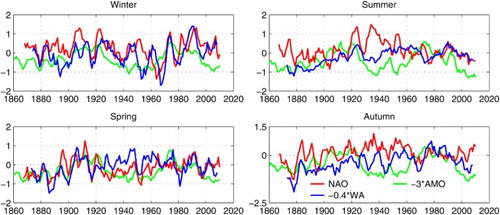Figures & data
Fig. 1 Map of the northwest Atlantic showing the five sea-ice regions (blue polygons), seven air temperature grid squares (dashed red squares), paleoclimate temperature site (red dot), and communities referred to in the text (green dots); GSL: Gulf of St. Lawrence, Nfld: Newfoundland.
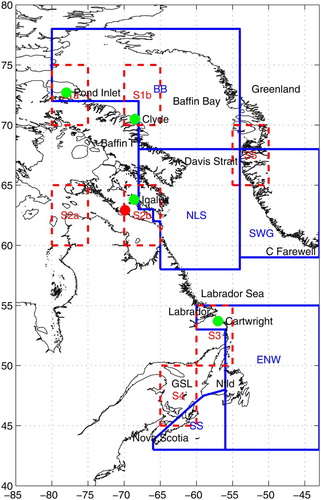
Fig. 2 Ice area or extent anomalies for (left) winter and (right) summer, using1961–1990 as a reference period. Anomalies of ice area for winter (January–March) and summer (June–September) are given for BB and NLS, and of ice extent for winter (February–April) are given for ENW and SS. The anomaly of the ice extent index for summer (May–July) is given for SWG. The blue and red lines show the unsmoothed and 5-year running means, respectively.
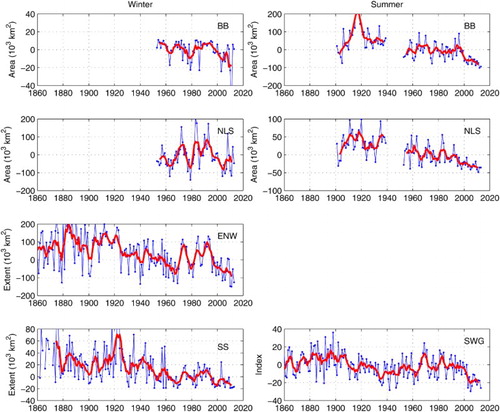
Fig. 3 Ice area anomalies in BB, NLS, and ENW for (left) spring (April–June) and (right) autumn (October–December). The blue and red lines show the unsmoothed and 5-year running means, respectively.
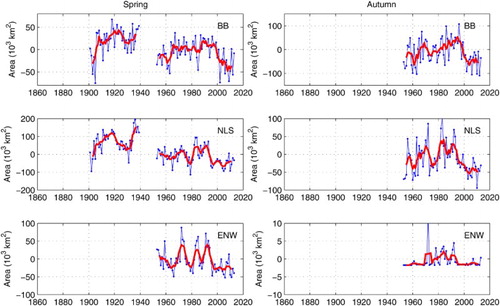
Fig. 4 (top) Annual iceberg season length anomaly, (middle) iceberg flux past 48°N anomaly, and (bottom) number of extreme observations of icebergs (October–September). The blue and red lines show the unsmoothed and 5-year running means, respectively. In the bottom panel, the shaded area represents the recent period not covered by the dataset.
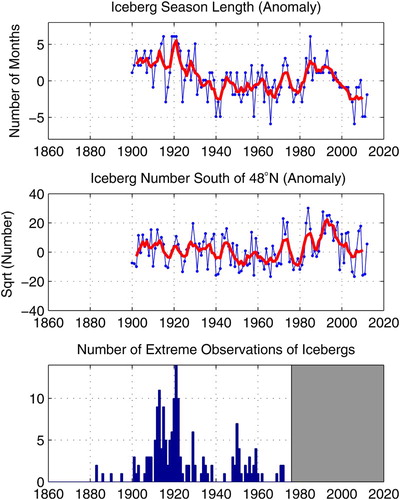
Table 1. Trends (T) in sea-ice area for the BB, NLS, ENW, and SS regions (percent per decade) and iceberg season length south of 48°N, iceberg season length (ISL; months per decade); correlation coefficients (r) of ice area with linear trends are also shown. The three numbers in each cell refer to the periods 1900–2011, 1953–2011, and 1980–2011, respectively. Winter is January–March; Spring is April–June; Summer is July–September; Autumn is October–December. For the ENW and SS regions in winter, ice extent was used instead of ice area and the time period was February–March. Trends and correlation coefficients significant at the 5% level are shown in bold.
Fig. 5 Seasonal air temperature anomalies from the CRUTEM4 dataset for (left) winter (December–February) and (right) summer (June–August) for grid squares S1–S5 in , with the y-axis inverted. The blue and red lines show the unsmoothed and 5-year running means, respectively. The reconstructed air temperature (5-year running mean) from Upper Soper Lake paleoclimate data is shown in green.

Fig. 6 Seasonal air temperature anomalies from the CRUTEM4 dataset for (left) spring (March–May) and (right) autumn (September–November) for grid squares S1–S5 in , with the y-axis inverted. The blue and red lines show the unsmoothed and 5-year running means, respectively.

Fig. 7 Seasonal NAO, WA (inverted), and AMO (inverted) anomalies shown as 5-year running means for winter (December-February), spring (March-May), summer (June-August), and autumn (September-November). NAO index data provided by the Climate Analysis Section, National Center for Atmospheric Research, Boulder, Colorado, USA, Hurrell (Citation1995); AMO (Enfield et al., Citation2001) data, and GPH data from the Twentieth Century Reanalysis (Compo et al., Citation2011) used to compute WA were provided by the National Oceanographic and Atmospheric Administration, Climate Prediction Center.
